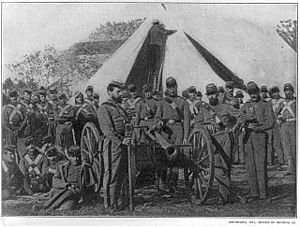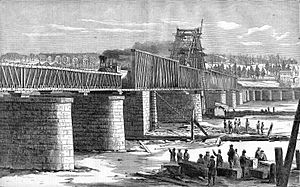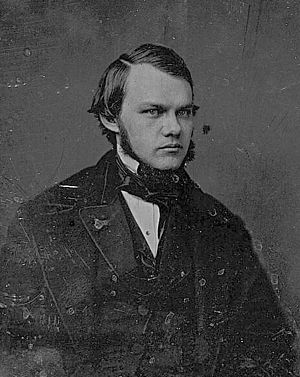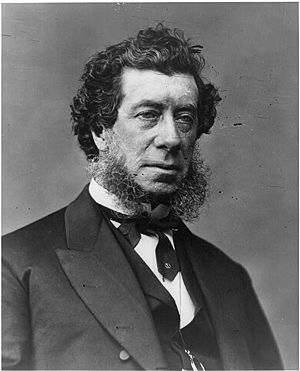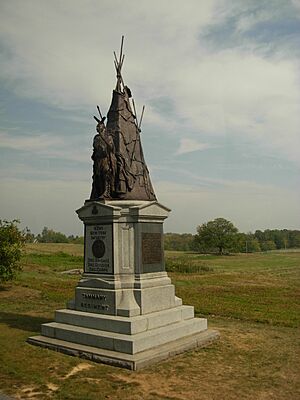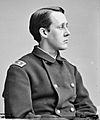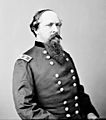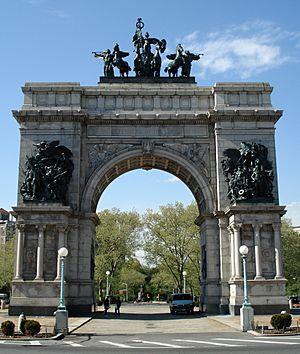New York in the American Civil War facts for kids
Quick facts for kids
State of New York
|
|||
|---|---|---|---|
|
|||
During the American Civil War, the state of New York played a huge role in national politics, the Union's fight, and how the war was shown in the news. New York was the state with the most people in the Union during the Civil War. It sent more soldiers to the U.S. army than any other state. New York also had many important military leaders. About 400,000 New Yorkers served in the U.S. armed forces during the war. Sadly, 54,000 of them died in battle, from sickness, or in enemy prison camps.
New York was divided politically. Some people strongly opposed the war, especially later on. Others were Radical Republicans who wanted to treat the rebelling Confederate States harshly. New York provided a key person for President Lincoln's team. It also had several important voices in the U.S. Congress.
New York's newspapers and media, mostly in New York City, shaped public opinion about the war. They influenced not only state politics but also national views. Famous newspapers and magazines from New York included The New York Times, New York Tribune, Harper's Weekly, and Frank Leslie's Illustrated Newspaper. German-born artist Thomas Nast was one of the first political cartoonists.
After the war ended, many memorials were built across New York. These honored specific groups of soldiers and officers. Many historical societies and archives also keep collections of items from the war.
Contents
New York's Role in Military Recruitment
Upstate New York was a leader in new ways of transportation, farming, and industry. Roads, canals like the Erie Canal, and railroads connected eastern cities with markets in the west. New York's farms were very productive. The Genesee area was known for its amazing grain production. Fast-flowing rivers powered many factories. Because of these growing opportunities, many people moved to upstate New York. They came from different backgrounds, including New Englanders, Dutch, Germans, Scots Irish, and immigrants from England and Ireland.
New York sent between 400,000 and 460,000 men to the war. This was almost 21% of all men in the state. More than half of these men were under 30 years old. Over 130,000 soldiers were born in other countries. This included 20,000 from Canada, 51,000 from Ireland, and 37,000 from Germany. The average age of New York soldiers was 25 years and 7 months. However, many younger boys lied about their age to join the army.
By the end of the Civil War in 1865, New York had given the Union Army:
- 27 regiments of cavalry (soldiers on horseback)
- 15 regiments of artillery (soldiers who use cannons)
- 8 regiments of engineers
- 248 regiments of infantry (foot soldiers)
Records show that 4,125 free African Americans from New York served in the Union Army. Three full regiments of United States Colored Troops were formed in New York. These were the 20th, 26th, and 31st USCT.
Some famous military groups from New York included the Excelsior Brigade. This group was led by Daniel Sickles, a former congressman. Francis B. Spinola also formed a brigade of four regiments called Spinola's Empire Brigade. Many early volunteer regiments came from older New York State Militia groups. One example was the 14th Brooklyn, known for its bright red pants.
The first organized unit to leave New York for the war was the 7th New York Militia. They left by train for Washington, D.C. on April 19, 1861. The 11th New York Infantry, a new group of recruits, left ten days later. One of the first people killed in the Civil War was Col. Elmer E. Ellsworth from Malta, New York. He died in May 1861 during a fight in Alexandria, Virginia.
New York's Support for the War Effort
New York had always been important to the U.S. military. The United States Military Academy in West Point trained many officers. New York Harbor had several military forts and bases. Many officers who became famous during the war had spent time in New York before 1861. MacDougall Hospital at Fort Schuyler became a major military hospital during the war. Davids' Island was an important prisoner-of-war camp for captured Confederates.
Many rich New York business owners helped the war effort. They provided supplies, weapons, and equipment. Railroad leader Cornelius Vanderbilt used his growing train network to move many troops through the state. The Union Navy hired Erastus Corning's iron works to make parts for the USS Monitor. This was the Navy's first ironclad (a ship covered in iron armor). The Brooklyn Navy Yard was also a key place for building and fixing naval ships.
Foundry owners Robert Parrott and his brother Peter made many cannons and ammunition. Their Parrott rifle, a new type of gun, was made in different sizes at the West Point Foundry. The National Arms Company in Brooklyn made firearms, including many revolvers. Other important weapon makers were the government's Watervliet Arsenal and the private Remington Arms Company in Ilion.
Wartime Politics in New York
In the 1860 presidential election, 362,646 (53.7%) New York voters chose Abraham Lincoln. 312,510 (46.3%) supported Democrat Stephen Douglas.
Powerful New York politicians helped create national policies during the war. Roscoe Conkling was a leading Radical Republican. He strongly supported fighting the war with full force. Other Republicans, like New York newspaperman Henry Jarvis Raymond, were more moderate. Raymond was the Chairman of the Republican National Committee later in the war. William H. Seward, a U.S. Senator from New York, became the Secretary of State. He was an important member of Lincoln's Cabinet.
However, the mayor of New York City, Fernando Wood, supported the Confederate side early on. He tried to get New York City to leave the Union and become its own entity, but he failed. New York City had many business ties to the South. By 1820, half of its exports were related to cotton. Also, many immigrants in New York worried that freeing slaves would mean more job competition for them.
When the war started, former New York Governor Horatio Seymour took a careful middle position in his Democratic Party. He supported the war but criticized how the Lincoln administration handled it. Seymour especially disliked Lincoln's increase of power and limits on freedoms during wartime. He also opposed Lincoln's support for emancipation (freeing slaves). In 1862, Seymour was elected governor again. He defeated Republican candidate James S. Wadsworth. As governor of the Union's largest state, Seymour was President Lincoln's most important Democratic opponent for the next two years. He strongly opposed Lincoln's military draft in 1863.
Alfred Ely, who led the House Committee on Invalid Pensions, was one of the first U.S. representatives captured by the Confederate Army. He was taken prisoner after the First Battle of Bull Run. He spent six months in a Confederate prison before being released.
In 1861 and 1862, former U.S. Senator Hamilton Fish joined with other New York men on the Union Defence Committee. They worked with the New York City government to raise and equip troops. They also spent over $1 million to help New York volunteers and their families. Later in the war, several New York politicians and businessmen helped start the Union League. This group supported the Union and Lincoln. It helped fund the Republican Party and charities like the United States Sanitary Commission.
During the Gettysburg Campaign in 1863, Governor Seymour sent many New York State Militia troops to Harrisburg. This was to help stop Robert E. Lee's Army of Northern Virginia from invading. The first Union soldier killed in Pennsylvania was Corporal William H. Rihl from Pennsylvania. He was serving in a company from the 1st New York Cavalry.
Impact of the New York Draft Riots
The New York Draft Riots in July 1863 were very violent. 120 civilians were killed and 2,000 people were injured. The riots also caused about $1,000,000 in property damage. This, along with a strong anti-war movement, made New York a very close state in the 1864 presidential election. 368,735 (50.46%) New Yorkers voted for Abraham Lincoln. 361,986 (49.54%) supported the Democratic challenger, former army commander George B. McClellan. Lincoln won all 33 electoral votes from New York.
The New York State Legislature approved money for the state's war effort. This included payments for soldiers, expenses, and support for soldiers' families. Total spending was over $152 million during the war.
Military Actions and New York Troops
No Civil War battles were fought in New York State. However, Confederate agents did set several fires in New York City. This was meant to scare people and gain support for the peace movement.
New York troops fought in almost every major battle in the Eastern Theater. Some New York units also took part in important campaigns in the Western Theater, though in smaller numbers. New Yorker John Schofield became the commander of the Army of the Ohio. He won the Battle of Franklin, which greatly hurt Confederate hopes in Tennessee.
More than 27,000 New Yorkers fought in the war's bloodiest battle, the three-day Battle of Gettysburg in July 1863. Nearly 1,000 New York soldiers (989) were killed in action. 4,023 were wounded, and many of them died later from their injuries or sickness. 1,761 New Yorkers were taken as prisoners of war. Many were sent to Southern prisons in Richmond, Virginia and other places. This battle had the largest number of casualties for New York troops in any single fight.
Many officers from New York died at Gettysburg. These included Brig. Gen. Samuel K. Zook, who lived in New York City for a long time. Col. Patrick "Paddy" O'Rourke from Rochester died a hero. He was leading the 140th New York Infantry into battle on Little Round Top. Col. Augustus van Horne Ellis was killed near Devil's Den on July 2. He was later honored with the only full-sized statue of a regimental commander on the battlefield.
During the entire war, New York sent over 370,000 soldiers to the Union armies. Of these, 834 officers and 12,142 enlisted men were killed in action. Another 7,235 officers and men died from their wounds. 27,855 died from disease. An estimated 5,766 more died while held in Southern prisoner-of-war camps.
New York City's Role in the War
New York City in the American Civil War
New York City, the largest city in the United States, was a busy place. It provided many soldiers, supplies, and equipment for the Union Army. Powerful city politicians and newspaper editors helped shape public opinion about the war and President Lincoln's policies. The port of New York was a good place to find recruits for the Army. Immigrants from Europe, mainly Irish and Germans, often joined the army soon after arriving. Recruiters like Michael Corcoran filled army lists with thousands of immigrants. This was in response to Lincoln's first call for 75,000 volunteers from New York.
Politically, the city was mostly controlled by Democrats. Many of them were part of a political machine called Tammany Hall. Led by William "Boss" Tweed, they won many offices in New York City, and even in the state legislature and as judges. They often did this through illegal ways. From 1860 to 1870, Tweed controlled most Democratic nominations in the city. Republicans were more common in upstate New York.
The New York Draft Riots
New York City had strong business ties to the South. It also had a growing immigrant population. Anger about conscription (the draft) led to mixed feelings about the Union and the Confederacy. This resulted in the Draft Riots of 1863. These were some of the worst civil unrest in American history. The week of July 11 to July 16, 1863, was called "Draft Week." Residents, mostly Irish immigrants, were angry about new laws from Congress to draft men to fight in what they saw as an unpopular war.
The riots that followed were the largest civil uprising in American history, besides the Civil War itself. President Lincoln sent several groups of militia and federal troops to control the city. Thousands of Irish rioters went through the streets of New York. They attacked Black people and burned buildings that belonged to the wealthy or supported the Union. Smaller riots also happened in other Northern cities, including other places in New York State, around the same time.
We don't know the exact number of deaths during the New York Draft Riots. However, historian James M. McPherson (2001) says at least 120 civilians were killed. Estimates suggest at least 2,000 more were injured. The total property damage was about $1 million. Historian Samuel Morison wrote that the riots were "like a Confederate victory." The city treasury later paid back one-quarter of the damage. Fifty buildings, including two Protestant churches, were burned down. On August 19, the draft started again.
Important Leaders from New York
New York was the state with the most people in the Union when the Civil War began. It had over 3.5 million residents. Because of this, it provided many important generals, admirals, and politicians. These leaders were either born in New York or spent a lot of time there before the war. Here are a few of New York's most famous people:
-
Bvt. Maj. Gen.
Romeyn B. Ayres
(East Creek) -
Maj. Gen.
Francis C. Barlow
(Brooklyn) -
Maj. Gen.
Daniel Butterfield
(Utica) -
Maj. Gen.
Abner Doubleday
(Ballston Spa) -
Maj. Gen.
James B. Ricketts
(New York City) -
Maj. Gen.
John C. Robinson
(Binghamton) -
Maj. Gen.
John Schofield
(Gerry) -
Sec. of State
William H. Seward
(Auburn) -
Gov.
Horatio Seymour
(Pompey Hill) -
Maj. Gen.
Daniel Sickles
(New York City) -
Maj. Gen.
Henry W. Slocum
(Delphi) -
Brig. Gen.
Francis B. Spinola
(Old Field) -
Maj. Gen.
George Stoneman
(Busti) -
Maj. Gen.
James S. Wadsworth
(Geneseo) -
Maj. Gen.
Gouverneur K. Warren
(Cold Spring) -
Maj. Gen.
Alexander S. Webb
(New York City) -
Cmmdr.
John Worden
(Sparta)
Other notable New Yorkers during the Civil War included:
- Union spy and Underground Railroad conductor Harriet Tubman
- War photographer Mathew Brady
- English-born artist Alfred Waud
- Newspaperman Horace Greeley
- Combat artist Edwin Forbes
James Wadsworth, one of the richest men in the state and a former Republican candidate for governor, was among the Union generals from New York who died during the war. Other generals who died included George D. Bayard from Seneca Falls, Daniel D. Bidwell from Buffalo, David A. Russell from Salem, Stephen H. Weed from Potsdam, and Thomas Williams from Albany.
Remembering the War: Memorials and Monuments
The Grand Army of the Republic and other groups of veterans in New York helped build hundreds of statues, fountains, and other memorials. They also built meeting halls where they could remember war events and keep their historical items safe.
Women in New York played a very important role at home during the war. They provided support, encouragement, and supplies to the soldiers. They also helped with groups like the United States Sanitary Commission and United States Christian Commission. Several New York women worked as nurses for sick and wounded soldiers in military hospitals across the state. On April 24, 1886, the state legislature allowed the New York chapter of the GAR to build a large memorial. This memorial is on the grounds of the New York State Capitol in Albany. It honors the women of the state for their "humane and patriotic acts during the war."
Some of the most impressive Civil War memorials in New York include the Soldiers and Sailors Memorial Arch in Grand Army Plaza in Brooklyn. This arch has bronze statues of Lincoln and Ulysses S. Grant on horseback. Grant, who led the Union armies later in the war, is buried in New York City in Grant's Tomb. The Soldiers' and Sailors' Monument in New York City also honors Union Army soldiers and sailors.
Green-Wood Cemetery in Brooklyn is the final resting place for hundreds of Civil War veterans, including several generals. Another large group of former generals (many not from New York) are buried at West Point Cemetery. These include George Armstrong Custer, George Sykes, Wesley Merritt, and Winfield Scott. Important Civil War cemeteries also exist in other towns. One is in Elmira, where the Elmira Prison prisoner-of-war camp was located. More than 2,000 Confederates who died there are buried in nearby Woodlawn National Cemetery.
Many New York regiments are remembered with monuments on battlefields across the country. The largest number are at the Gettysburg Battlefield in southern Pennsylvania. The state of New York built a large marble memorial near the top of Cemetery Hill. Almost every New York unit that fought in the battle later built its own monument near where they fought. Several more New York monuments are also found at Antietam National Battlefield.




